|
 Dermocybe alienata Dermocybe alienata
SynonymsCortinarius alienatus
BiostatusPresent in region - Indigenous. Endemic
Images (click to enlarge)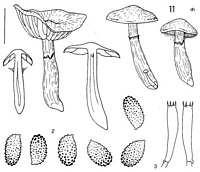
Caption: Dermocybe alienata: 1. carpophores. – 2. spores. - 3. basidia. - 4. pileipellis. | 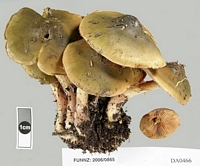
Caption: Col. DA0466, FUNNZ: 2006/0865, See public note for more information
Owner: FUNNZ | 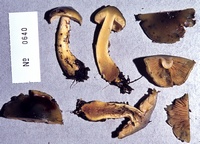
Caption: ZT0640
Owner: E. Horak: © Creative Commons Attribution-Noncommercial 3.0 New Zealand | 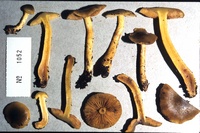
Caption: ZT1052
Owner: E. Horak: © Creative Commons Attribution-Noncommercial 3.0 New Zealand | 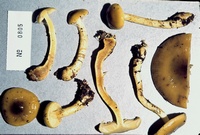
Caption: ZT0805
Owner: E. Horak: © Creative Commons Attribution-Noncommercial 3.0 New Zealand | 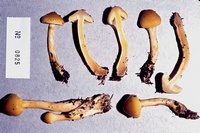
Caption: ZT0825
Owner: E. Horak: © Creative Commons Attribution-Noncommercial 3.0 New Zealand | 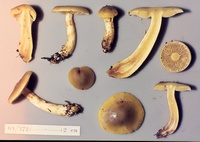
Caption: ZT69-372 , Holotype
Owner: E. Horak: © Creative Commons Attribution-Noncommercial 3.0 New Zealand |
Article: Horak, E. (1988) [1987]. New species of Dermocybe (Agaricales) from New Zealand. Sydowia 40: 81-112.
Description: Pileus -60 mm, hemispherical or convex becoming broadly umbonate or obtusely campanulate finally depressed around umbo, margin distinctly inrolled in young specimens; centre black-olive, pale fuliginous-green or grey-green, fading towards margin to ochre-yellow or golden yellow; glutinous to viscid, remaining sticky, occasionally radially wrinkled, margin striate in aged carpophores, conspicuous veil remnants absent. - Lamellae 20-30, -7, adnate to broadly emarginate, subdecurrent with tooth, -7 mm wide; pale yellow to apricot (any green-olive tinge absent) turning yellow rust brown with age; edges concolorous, entire to serrulate. - Stipe -100 x-8 (-15 at base) mm, (sub)fusoid, subbulbous or clavate at base, rarely cylindrical, single or cespitose; pale yellow (occasionally with pale grey-olive shine); glutinous to viscid from base to subpersistent fibrillose or agglutinated cortina, apex dry, sometimes with yellow rhizoids at base; solid when young, becoming hollow. - Context pale yellow (turning brown upon bruising), distinctly olive-grey beneath cuticle of pileus. - Odour and taste acidulous to (weakly) raphanoid. - Chemical reactions on pileus (and stipe): KOH-red to red-brown.
Spore print rust brown. - Spores 7-8.5-11 x (4-) 4.5-5.5 µm, oval to subelliptical, minutely verrucose but with coarse warts at apex (often embedded in perisporial remnants), rust brown. - Basidia 25-35 x 6-7 µm, 4-spored, often with purple-brown plasmatic pigment. - Cheilocystidia absent. - Pileipellis an ixocutis composed of cylindrical, strongly gelatinized, entangled hyphae (2-6 µm diam.), subcutis cellular, in KOH with brilliant red-purple both plasmatic, encrusting and intercellular pigment which scarcely dissolves in KOH, solvent stains pale olive brown, rarely with oleiferous hyphae. - Clamp connections present.
Habitat: On soil both in Nothofagus and Leptospermum forests. - New Zealand.
Notes: In New Zealand D. alienata represents the most common species of the genus. It is found in mixed broadleaved forests but also occurs in pure stands of both Nothofagus spp. and Leptospermum spp.
Due to the olive-green tinge on the yellow pileus D. alienata is readily confused with D. olivaceonigra or D. icterinoides. According to personal experience the definite identification and/or separation of the species belonging into this complex is often not possible in the field. A thorough microscopical examination should be supported by data obtained from thin-layer chromatography of the anthraquinonoid pigments (KELLER & al., 1988). Skyrin, hypericin and to a lesser degree dermolutein are the principal pigments which are responsible for the yellow colours of D. alienata. A similar pigment pattern is also found in D. icterinoides which, however, differs not only by the presence of additional pigment components but also several other distinctive macroscopical characters.
|